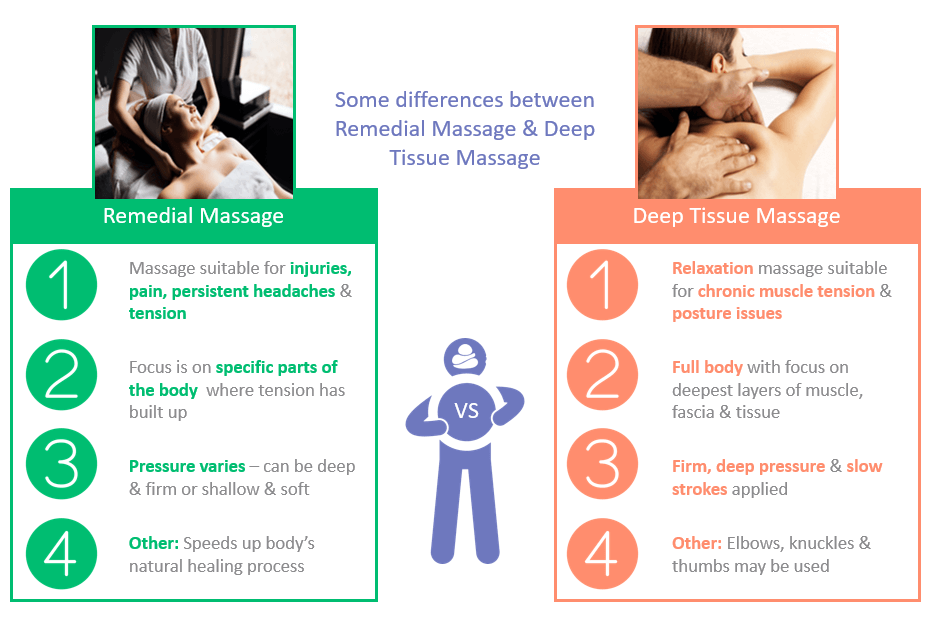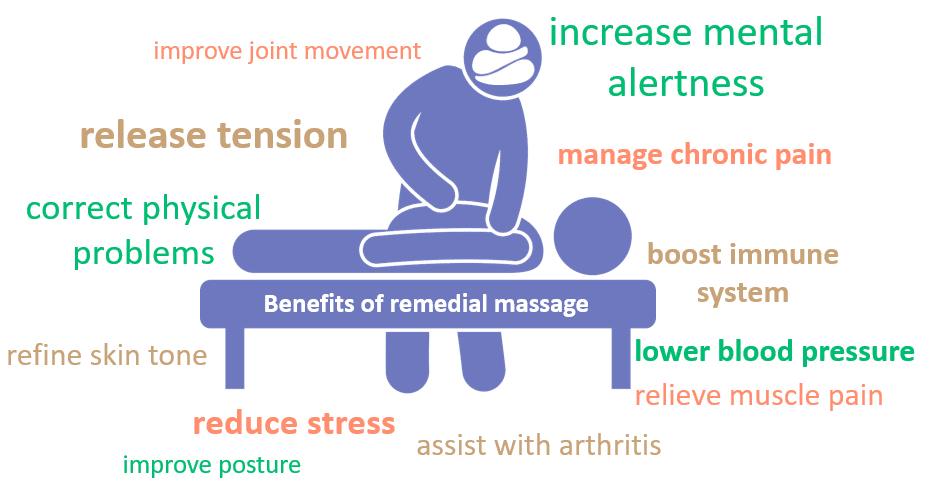Need a massage that eases deep muscle tension, gives pain relief and promotes healing?
If so, remedial massage or deep tissue massage may help you feel better.
They’re both rejuvenating massage styles that support the deeper layers of connective tissues. This is ideal if you have musculoskeletal pain and want to improve your quality of life.
Yes, they’re possibly a better choice than other forms of massage, like:
-
Swedish massage
-
Thai massage
-
hot stone massage
-
lymphatic draining massage
-
craniosacral massage
-
sports massage therapy + more.
But, which of these 2 massage styles is best for YOU?
Let’s take a look at remedial and deep tissue massage to see which suits your needs.
What is a deep tissue massage?
Deep tissue massage is a form of relaxation massage that supports your entire body.
Massage therapists set a rhythm using long, flowing strokes. They apply firm, deep pressure to go beyond soft tissues. Massage techniques target the deep layers of your muscles where they attach to bones.
After your treatment…
You may notice an increase in discomfort, before you get pain reduction. If this occurs, you’ll know that many layers of muscles have been treated. Expect a wide range of benefits after 24 hours or so, including injury prevention.
What is a remedial massage?
Remedial massage is not a whole-body massage. Instead, it focuses on releasing tension from specific muscle groups, e.g. the shoulder or lower back.
Just like a deep tissue massage, it may involve firm pressure. However, when performed properly, remedial massage varies in strength and intensity. This means it can involve deep and firm strokes or be shallow and soft. It primarily uses essential kneading movements to manipulate soft tissue structures, and deeper. Remedial massage techniques are also used by sports massage therapists.
After your treatment…
You may experience some discomfort for a day or so. This usually won’t interfere with your everyday life. But, the degree of discomfort will vary for each person. Allow yourself time to rest after your massage and your healing process will be easier.

Benefits of deep tissue massages
This massage style releases knots in stressed, overworked muscles and connective tissues. It also stimulates blood flow and reduces inflammation to give relief from pain. That’s why it benefits chronic muscle pain, muscle tension and range of motion. Many people also find it eases discomfort from scar tissue adhesions.
It’s also an excellent physical therapy for stress reduction, postural issues, arthritis and deep tissue pain. It promotes self-healing, sleep and mental health. Use deep tissue massage if you want to efficiently build muscle and burn calories.
Benefits of remedial massages
Remedial massage can treat a wide range of conditions that impact the musculoskeletal system. It’s excellent for common injuries, sports injuries, neck pain, back pain, sciatic pain, tight muscles and tension headaches.
These massage treatments increase the flow of blood to your muscles and improve flexibility. That’s why they have the potential to speed up your body’s natural healing processes.
Both amateur athletes and professional athletes use this type of massage therapy. Many pros have a remedial massage therapist on their care team. That’s how important remedial therapist’s are to physical activity recovery.

Which is better for body pain?
In reality, remedial and deep tissue massage can assist body pain.
They both support the muscle tissues and help:
- acute and chronic pain conditions
- injury management
- extreme muscle tension
- muscle recovery
- faster recovery in athletic individuals.
One of the key differences is the stroke type.
Deep tissue massage uses slow strokes that penetrate deep into the muscle layers. It’s a full body experience that can also double as a relaxation treatment.
Remedial massage focuses on kneading techniques that target one muscle group. It’s best for musculoskeletal pain that sits in one area of your body.
Is deep tissue or remedial massage best for you?
Ask yourself the following questions before booking your massage:
What is my current pain level?
Low to medium pain: Both types of massage could benefit you.
High pain: Start with a remedial massage. Going deep into the muscles, via a deep tissue massage, may stir up too much pain for you.
Do I only have pain in ONE area?
Choose remedial massage therapy if you want help with only one muscle group. Your therapist will intently focus on that area, giving it all the care and attention it needs to help you feel better.
Do I want pain reduction and relaxation benefits?
If both are important to you, consider a deep tissue massage. It’s the closest thing you’ll find to a physical therapy and Swedish massage combo.
Do I also want an emotional healing component?
Both types of massage can support emotional healing. As the muscles relax, trapped emotions are freed and allowed to release from your energy system.
Deep tissue massage often brings major emotional releases. It can even release negative emotions from years ago. This may be felt as deep pain or a need to cry during the massage.
Remedial massage also supports emotional health. The intensity is often less, though it can be just as powerful. If you have a desire to laugh, cry or sigh during the massage, you’re probably letting go of old emotions.
Ready to book a massage?
Avaana can help you find a local, trust massage therapist near you.



